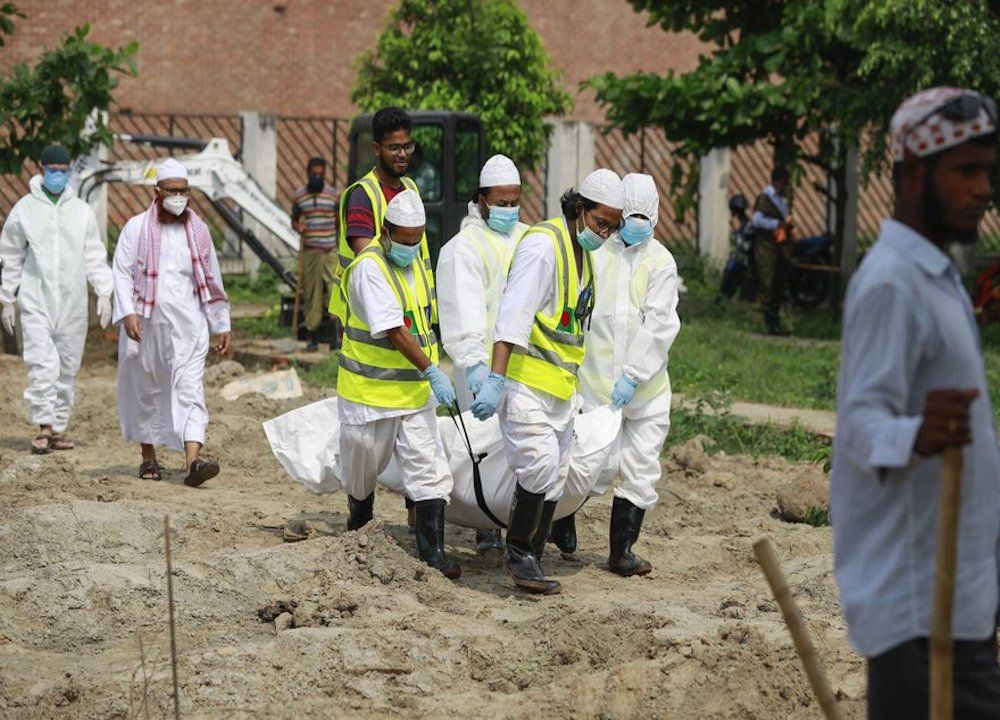Covid-19: Will Bangladesh follow India into breakdown?
The pandemic is now hitting India hard. Bangladesh could be next.

With Covid-19, Bangladesh has bucked both the expected and the predicted.
Remember the UN report at the very beginning of the epidemic in March 2020 which stated that “between half a million [to] 2 million” deaths could result in Bangladesh, unless immediate steps were taken to suppress the virus. And then there was the Imperial College study published around the same time which suggested that only a “sustained lockdown” would keep deaths to as low as 52,000. And further to that there was additional Imperial College modelling which in June 2020 suggested that as many as 10,000 people could die in one day.
All this modelling proved to be highly inaccurate.
A year on, as of April 28th, the official number of deaths is 11,305 — a death rate of 68 deaths per million. This is a very low figure compared to other countries, in the United Kingdom for example, the death rate is 1,870 deaths per million.
Of course, no one believes that Bangladesh’s official death figures are anywhere near accurate. There is no death certification scheme in Bangladesh, and the official Covid-19 death tally only covers deaths in certain identified hospitals, leaving out deaths that occurred at home or in health centres around the country.
No one knows — or will know — the accurate number of Covid-19 deaths in Bangladesh, but many suggest that the real number is likely to have between three to five times the official figure. However, even if one took the higher number, and there were as many as 50,000 deaths, this would still be a number of deaths that confounded the original modelling.
Bangladesh’s Awami League government sought to take credit for these low numbers, though there is little evidence to support this. In fact, just like in many other countries, Bangladesh government’s management was pretty chaotic, exemplified by its inability (or unwillingness) to even provide accurate information on numbers of positive Covid-19 cases.
There is no clear understanding why Bangladesh fared so much better than other countries, though anyone interested in looking at what factors might have been behind the low number of deaths should read Siddhartha Mukherjee’s article in the New Yorker: “Why Does the pandemic seem to be hitting some countries harder than others?” Amongst other reasons, the article suggests that “prior immunity” or greater “open air ventilation” could help explain why countries like Bangladesh have suffered fewer deaths. Whatever the explanation, the country was very fortunate indeed.
However, is Bangladesh’s luck changing?
In early February, the daily official number of deaths dipped on a number of occasions to as low as five, and many might have thought that the country had completely defeated the virus. But in early March, the numbers started rising precipitously, and 45 days later, on April 12th, there were 112 Covid-19 deaths reported. Since then the official number of daily deaths has started to decline, so it is possible that the peak of this second wave has now passed. If so, Bangladesh has again been relatively lucky, as the South African variant of the virus — very likely to be responsible for this new wave — has been far more deadly in other countries (on one day in January 2021 in South Africa there were 839 deaths).
Now there is the so-called “Indian variant” — which in particular refers to the double mutant strain — which almost certainly has entered Bangladesh.
In India, this variant has resulted in huge increases in the number of Covid-19 infections crippling the healthcare system, even in the country’s capital city of Delhi. Earlier this week there were as many as 3,647 deaths on one day this week (though the death rate remains relatively low at 148 deaths per million). Though this second wave of infections started around the same time as the one suffered by Bangladesh, in India it still has not reached its peak.
There is therefore good reason to be concerned about what might be the impact of this Indian variant when it starts to spread in Bangladesh — something that is likely to happen soon. If the previously low death rates in India and Bangladesh from the initial Covid-19 strain were the result of prior immunity, or other similarities shared by both populations, could this suggest that Bangladesh will suffer the same disastrous impact from this new variant that is now being experienced in India?
However, as always another reading of the situation is possible. It may be the case that Bangladesh’s experience of the South African variant which has infected greater numbers of the population, providing further immunity from the virus, might help reduce the impact of this new Indian variant, particularly in Dhaka.
Commentators on Bangladesh — including this one — have learnt the hard way that predicting the impact of the Covid virus in Bangladesh is a fool’s errand.
Nonetheless, one can only hope that the Bangladesh government is looking over its shoulder at India, and — while hoping that the wheel of fortune turns again in its favour — is at the same time planning for the eventuality that this time the country may not be so lucky.●
David Bergman (@TheDavidBergman) — a journalist based in Britain — is Editor, English of Netra News.